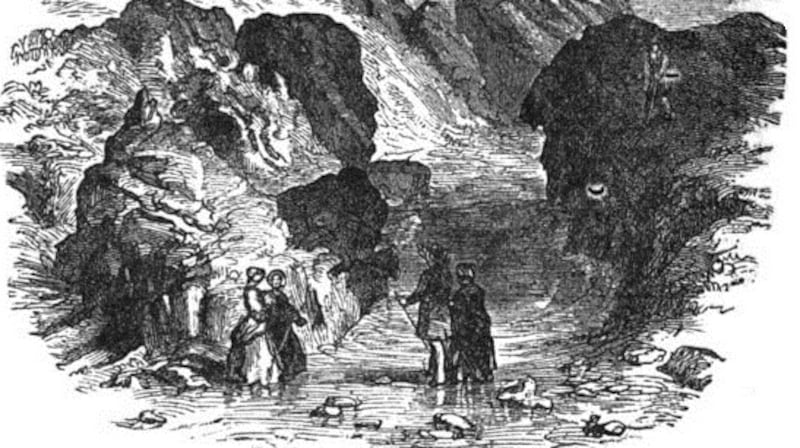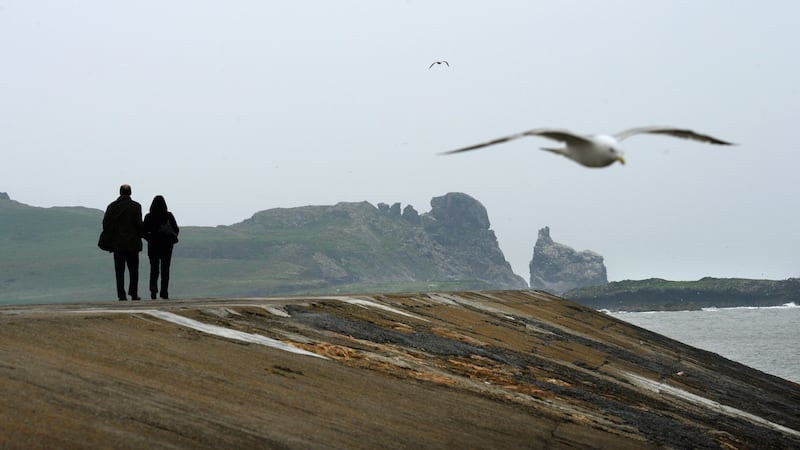On sunny weekend days, the little boats that take people to Ireland's Eye - a small, rocky island just off Howth Harbour in Dublin - are routinely full. People wrap up and squash in for the short voyage, phones in hand, snapping away as they approach the hilly landmark. A Martello tower and the ruins of an 8th century church are the only real beacons of previous life and it's long been uninhabited.
Tourists, rock climbers and birdwatchers are the island’s regulars and it is the type of postcard fodder that doesn’t make the news often, save for the odd gorse fire. But that wasn’t always the case.
"Until some seismic or other supernatural agency shall happily have effaced Ireland's Eye from the surface of the waters where it now stands, and perhaps long after, it will be associated with one of the foulest and strangest murders that have ever been perpetrated." Those are the words that begin a crime feature in The Weekly Irish Times on April 23rd, 1904, recalling a time when this tourist favourite was associated with a sinister mystery which gripped Victorian Dublin fifty years earlier.


William Burke Kirwan and his wife Maria lived at number 11 Upper Merrion Street in Dublin's city centre. In September 1852, the couple were renting a room in Howth, from where they would often take the journey over to the little island. William, an artist of "no mean order", sketched the craggy mounds and shoreline, while Maria*, described as a woman of "prepossessing appearance" and a "remarkably fine looking person", accompanied her husband on these trips, taking walks and swimming in the sea.
Quoting from the Freeman's Journal at the time, The Irish Times archive piece describes the events on the "beautiful autumn day", Monday September 6th, when the Kirwans set out from Howth Harbour for the last time.
Patrick Nangle, a local fisherman, had been paid by William to drop the pair over at 10am. Maria asked the small crew - consisting of Nangle and three other men - to return at 8pm that night for the homeward journey. Carrying a basket and a small bag, they walked from the landing place and the fishermen returned to the mainland.
When Nangle’s boat returned that night, the men called out for the couple.
"It was then dark. Mr Kirwan answered and said he was there. They then got into the landing place and Mr Kirwan was standing on the bank above," reads The Irish Times account.
‘Gone astray’
Maria, the boatmen found, was missing. Kirwan, when asked where she was, said he was separated from his wife after a shower of rain, and had been looking for her.* One of the boatmen went with Kirwan to search the island and Nangle followed soon after, walking east along the shore.
At about 10pm, they found Maria’s body. “The body was on the rock, just out of the water,” reads the piece. She was wearing her bathing suit and her clothes were discovered a short distance away. William “appeared to be in very great trouble when the body was found”.
The above story was recalled at the inquest of Maria's death the next day in Howth. The remains were examined by a medical student named James Alexander Hamilton, who noted various scratches on the body, which were deemed to have been likely caused by the rocks. He concluded that Maria Kirwan accidentally drowned while swimming.
So concluded the first part of the Ireland's Eye saga, but as The Irish Times put it in 1904, there remained "powerful factors at work in the interest of justice, and bearing directly on the guilt of William Burke Kirwan".
Several people standing on the mainland pier later reported hearing “heart-rending, agonising screams,” from the island on the evening of Maria’s death, similar to the sounds “uttered by those who see themselves at the point of death from some violent cause”.
Then, shortly after the inquest, police made a discovery that tied motive to the mystery. William was found to be leading a double, secret life with a different woman on Lower Dorset Street, with whom he had children.
Theresa Kenny, like Maria, believed she was the only woman in William's life, until the two women encountered one another about six months before Maria's death - around the time the Kirwans moved to Howth, according to testimony from the first day of the trial reported in the Anglo-Celt.
Infidelity
Maria's remains were exhumed from her grave at Glasnevin Cemetery on October 6th, 1852, and a post-mortem examination was performed. Kirwan was arrested on suspicion of murder.*
Infidelity was a scandal of larger proportions in Victorian Dublin and when the case went to trial in December 1852, Green Street Courthouse was thoroughly “packed” and “crammed” for the three days, such was the fierce interest.
Kirwan pleaded his innocence, and was "needless to say. . . ably defended" by Isaac Butt.*
The evidence against Kirwan was mainly circumstantial. Witnesses reported that Kirwan's legs were wet on the night of Maria's death, and the screams heard in the harbour would prove to be damning. Patrick Nangle gave evidence to the effect that Kirwan carried a "sword cane", though that was not corroborated. Among the other evidence, according to the piece in The Irish Times, was that William insisted his wife's body be washed before the first examination. Testimony regarding fighting between the couple, given by their landlady in Howth, was also heard, according to the Anglo-Celt.*
The evidence surrounding the examination of Maria’s remains was a different story, complicated by the fact that when they exhumed her body, she was found to have been buried in a wet area of the cemetery, and water had seeped into the coffin. “The medical evidence, as usual, was contradictory,” according to the article.
The Irish Times article said: “The theory of the Crown was that Kirwan first murdered his wife with the needle-like sword and afterwards placed the body in the position in which it was found by the boatmen.”
In fact, the Crown theory proposed that Maria’s death was caused by sudden stoppage of air, without getting too specific. One scenario suggested was that Maria was forcibly submerged – others suggested Kirwan used a sheet reportedly found near the body to carry out the murder. The “sword cane” alluded to by The Irish Times was entered into evidence by Pat Nangle on the first day of the trial, but not granted much weight at the time. The defence suggested – without success – that Maria died following an epileptic seizure.*
The jury found Kirwan guilty of murder. Judge Philip Cecil Crampton sentenced Kirwan to death, though, as the report notes, he didn't immediately set an execution date.
Doubt
Despite the verdict being received “with great satisfaction by those in court”, the aftermath saw newspapers “teemed with letters”, by people who urged “that there was a doubt and that Kirwan should get the benefit of it”. A public meeting was held in London over the verdict “and a movement was set on foot for, at least, a commutation of the death sentence. That movement daily gained strength.”
That strength proved effective and Kirwan's death sentence was reduced to life penal servitude by the lord lieutenant of Ireland.
"Even the jury who convicted Kirwan (was) very greatly pleased with the commutation and the foreman, a Mr Dennis, wrote a long letter to the newspapers, in which, inter alia, he declared that the minds of the jury were much relieved," according to the author of The Irish Times piece.
The author goes further to say there was not a “shadow of a doubt that had not Kirwan’s married life been what it was proved to be, the jury would never have agreed”.
Accusations quickly mounted that the new sentence was a product of public pressure. Such was the backlash that the under secretary at the time, John L Wynne, defended the move in a newspaper letter, in which he assured that the lord lieutenant “neither solicited, nor received the advice of any other person whatsoever”.
Kirwan served more than 25 years penal servitude for the murder of his wife on Ireland's Eye. He was released in January 1879 and, according to The Irish Times, was recognised by some about Dublin city at the time.
This story is part of the Lost Leads series - a re-visiting of lesser-known stories that have made the pages of The Irish Times since 1859. What can you find? Let us know @irishtimes. For more information on subscribing to the archive, visit www.irishtimes.com/archive
*This article was amended on April 16th, 2021

